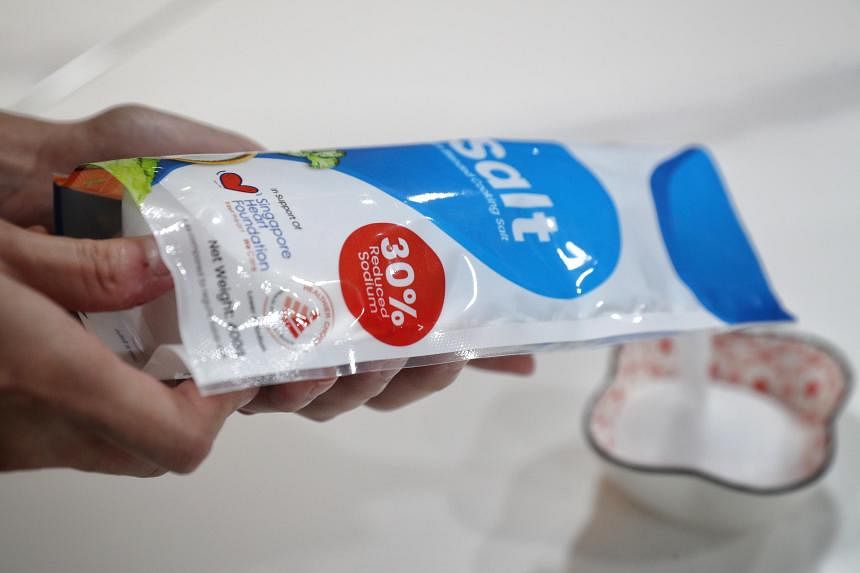CUT OUT SALT
Uptick in sales of low-sodium salt amid push to reduce sodium consumption
FairPrice and Sheng Siong introduced K-Salt, a more affordable
lower-sodium salt product, in October.
PHOTO: ST FILE
Zhaki Abdullah and Lucas Tan
SINGAPORE – Some supermarkets here are seeing greater interest in low-sodium salt, amid efforts by the Health Promotion Board (HPB) to reduce sodium consumption for health reasons.
In September, HPB said it was working with major retailers to introduce house brand lower-sodium salt by 2023, with supermarket chains FairPrice and Sheng Siong introducing K-Salt, a more affordable lower-sodium salt product, in October.
This is in line with efforts by the authorities to cut the sodium intake of people here by about 15 per cent over the next five years.
Singaporeans consume an average of about 3,600mg of sodium a day – well above the World Health Organisation’s recommended daily salt intake of not more than 2,000mg, or about one teaspoon.
Excessive sodium consumption can result in high blood pressure, which can lead to heart attacks and strokes.
A spokesman for Sheng Siong said the supermarket chain, which has 67 outlets here, has observed an uptick in demand for lower-sodium salt since HPB’s September announcement.
He added that Sheng Siong currently carries three types of low-sodium salt products, though these make up less than 5 per cent of its total sales of salt products.
DFI Retail Group, which operates the Cold Storage, Giant and Market Place supermarkets, among others, also said it has seen an increase in sales of low-sodium salt since late September.
“While supermarkets under the DFI Retail Group have not started selling the low-sodium K-salt, we have plans to bring in K-salt soon,” said a DFI spokesman.
The group currently sells one type of low-sodium salt and intends to source for more such products, the spokesman added.
Neither Sheng Siong nor DFI provided figures for the increase in sales of low-sodium salt.
FairPrice noted that K-Salt is currently available at more than 60 of its outlets, as well as online. The supermarket chain said it is too early to provide meaningful data on sales of K-Salt, but added that it is optimistic about the demand for lower-sodium options from a growing number of health-conscious consumers.
Checks on some smaller chains, such as the Ang Mo and U Stars supermarkets, found that they also carry low-sodium salt alternatives.
However, several minimarts that The Sunday Times visited did not carry such products.
“Only if the customer asks (for them), then we will sell,” said 45-year-old Veerappan Sivaraman, who runs the Fairmart Mini Mart in Toa Payoh.
Of the 14 consumers approached, only two said they were aware of such low-sodium substitutes.
“I usually buy low-sodium salt as it is healthier and tastes less salty than normal salt,” said 73-year-old retiree Neo Chew Keat.
One way to encourage the adoption of low-sodium salt is by subsidising its cost to encourage more people to try it, said Assistant Professor Mary Chong from the National University of Singapore’s Saw Swee Hock School of Public Health. Greater demand from consumers is also likely to bring prices down, noted Prof Chong, a clinical dietitian by training.
Although K-Salt is cheaper than other low-sodium alternatives – which can be up to 10 times more expensive than normal salt – it is still significantly more expensive than conventional table salt. A 400g packet of K-Salt costs $2.50, while a 500g box of Pagoda fine salt is typically priced at 50 cents.
“Providing samples of low-sodium alternatives to the public, along with recipes on how best to use them, is another practical way of encouraging uptake,” said Prof Chong.
She cautioned that while low-sodium salt substitutes can help reduce blood pressure levels, people should still watch how much they use as these can still contain a considerable amount of sodium.
For those with kidney disease or who are taking certain medicines, such as potassium-sparing diuretics and angiotensin-converting enzyme inhibitors, using such products excessively could lead to dangerously high potassium levels, she added.
No comments:
Post a Comment